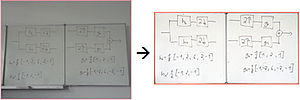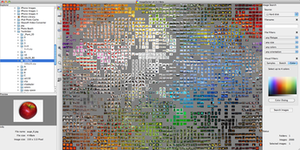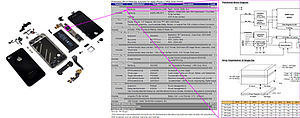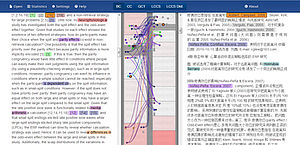Projekte im Wintersemester 2014/15
Table of contents
Digitale Stoffmustersammlung
Prof. Debora Weber-Wulff. A project in cooperation with FB 5.
It was kept in the cellar of the HTW for many, many years. Prof. Sibylle Einholz found the book with cloth patterns that were collected from 1836 to 1856 - an amazing discovery noted in the local newspaper. Prof. Dorothee Haffner is in the process of restoring the materials and scanning them in, they are creating a big database of these cloth patterns.
BUT: how do you go about navigating such a collection? How do you search for patterns such as "something with diamonds and in yellow"? The goal of this project is to provide an easy-to-use search and navigation for that database, and to deal with the problem of finding patterns that are not tagged or categorized.
Whiteboard Capture
Prof. Klaus Jung
In meinen Lehrveranstaltungen benutze ich immer häufiger die Tafel, um die Dinge langsamer zu entwickeln und zu den Folien zusätzliche Skizzen, Tabellen, Rechnungen anzubieten. Entsprechend sehe ich immer häufiger, dass das Tafelbild von den Studierenden mit ihrem Smartphone abfotografiert wird. Die Aufnahmen sind oft nicht gut belichtet, geometrisch verzerrt und nicht genau auf die Tafel zugeschnitten.
Hier setzt die Projektidee an: Zu erstellen ist eine App für das Smartphone (Android oder iOS), die aufgenommene Tafelbilder automatisch verbessert, entzerrt, zuschneidet und am richtigen Ort ablegt. Dieser Ort könnte lokal auf dem Gerät oder in einer Webanwendung sein. Auf Grundlage von Metadaten (Datum und Uhrzeit der Aufnahme, eigener Stundenplan, LSF-Anbindung?) könnte eine systematische, dem richtigen Kurs zugeordnete Ablage erfolgen. Weitere Ideen für Features, wie das Hinzufügen von Anmerkungen, Export als PDF o.ä. können im Projekt entwickelt werden. Die Funktionen der Bildverarbeitung, wie z.B. das automatische Zuschneiden und Entzerren, werden sicherlich manuelle Korrekturmöglichkeiten bekommen.

Revamped ImageSorter
Prof. Kai Barthel
Das Programm ImageSorter ist 2007 im Studiengang IMI entstanden und wurde bis 2009 weiterentwickelt. Die Techniken, die im ImageSorter zum Einsatz kommen, gewannen beim internationalen Canto-Partner-Meeting den Preis für das innovativste Produkt 2009. ImageSorter wurde tausendfach heruntergeladen und wird bis heute genutzt, obwohl es seit langem keine Updates gab. Besonders geschätzt wird am ImageSorter die Möglichkeit, lokal gespeicherte Bilder nach ihren visuellen Ähnlichkeiten auf einer 2D-Ebene automatisch zu sortieren. Die damit gewonnene Übersichtlichkeit hilft, Bilder wiederzufinden, deren Aussehen dem Benutzer ungefähr bekannt sind.
Bisher läuft das Programm nur unter Windows und Mac OSX. Ziel dieses Projektes ist es, den ImageSorter als Google Web App neu zu konzipieren und zu optimieren. Das Hauptaugenmerk liegt neben der neuen Programmstruktur auf der Ausarbeitung eines neuen vereinfachten Interaktions-Design.

Conflict and Social Justice in the Electronics Supply Chain
Heba Amin Elmahamly
This project is a thorough materials analysis of the components of common contemporary digital devices. From the surfaces we contact every day to the functioning parts inside, this project aims to produce a comprehensive labour model of the instrument by tracing the material origins back through their various industrial processes.
This project problematizes and investigates how to best visualize and relay information about the far-reaching consequences of the every day technological tools we use today. It integrates the consciousness of technological development with that of resource exploitation and links the material of our devices to migration flow, particularly on the African continent. With existing data sets as well as a crowd-sourced knowledge base, we will explore data visualization as a tool for activism. Through collaborations with local organizations and case studies, students will construct real-time data visualizations and other electronic media products which may help us understand and position ourselves politically with regard to these same media products.
In collaboration with Baruch Gottlieb at ThoughtWorks Werkstatt Berlin: werkstatt.tw

Enhancing CitePlag - a Web-based Plagiarism Detection System
Paul Stüber
Today’s plagiarism detection systems can only identify copied text, but not intelligently disguised forms of plagiarism, such as translated, paraphrased, and idea plagiarism. To alleviate the shortcomings of currently available systems, the SciPlore team in collaboration with HTW students developed CitePlag (www.citeplag.org). CitePlag is a prototype of a plagiarism detection system that combines a number of novel detection approaches, the most important of which is Citation-based Plagiarism Detection (CbPD). CbPD analyzes the in-text citation patterns in scientific documents, which are language independent and often show similarity even if texts have been translated or strongly paraphrased. Our evaluations, e.g., using the plagiarized doctoral thesis of K.-T. zu Guttenberg, or 180,000 biomedical articles, showed that CbPD allows for the detection of heavily disguised academic plagiarism that otherwise would not have been machine detectable using traditional approaches.
The Task
While CitePlag has already proved its value, we envision many enhancements to the system.
In the beckend, we like to
- Integrate semantic detection methods;
- Enhance the PDF processing capabilities;
- Increase CitePlag's reference collection.
In the frontend we like to
- Enable a unified document format;
- Visualize semantic similarity features;
- Realize an interactive “dashboard” area.
We invite you to support us in realizing some of these enhancements as part of your bachelor project. You are also welcome to pursue your own ideas to improve CitePlag. For a detailed description of the project, possible tasks, and contact information, please visit: www.sciplore.org/t/enhancing_citeplag.pdf

Game Programming in Zusammenarbeit mit dem Studiengang Game Design
Prof. David Strippgen
Die Studierenden des Game Design Studiengangs entwerfen Spiele-Ideen und Spiele-Welten, die in einer Projektphase zum Leben erweckt werden sollen. Dazu ist die praktische Mitarbeit von IMI-Studierenden nahezu unumgänglich (und sehr gefragt). Sie werden die technische Realisierbarkeit der Ideen kritisch begleiten und informatisch umsetzen. Diese Aufgabe ist typisch für eine mögliche Position als Spiele-Entwickler im Informatikbereich der aktuellen Spieleindustrie.
Die vorhandenen Projekte werden größtenteils mit der Game Engine "Unity" umgesetzt. Eine Kenntnis der Engines wird nicht vorausgesetzt, eine zügige und engagierte Einarbeitung aber schon. Die Projektteilnehmer werden in jeweils eine Development-Unit für die beiden Engines verteilt (eigene Präferenzen werden dabei berücksichtigt). Die beiden Teams sind eine Mixtur aus Bachelor und Master-Studierenden.
Es wird viele Projekte geben, die separat vorgestellt werden, dann lernen sich die IMIs und die GDs kennen und formen Teams. Genauere Informationen gibt es später.